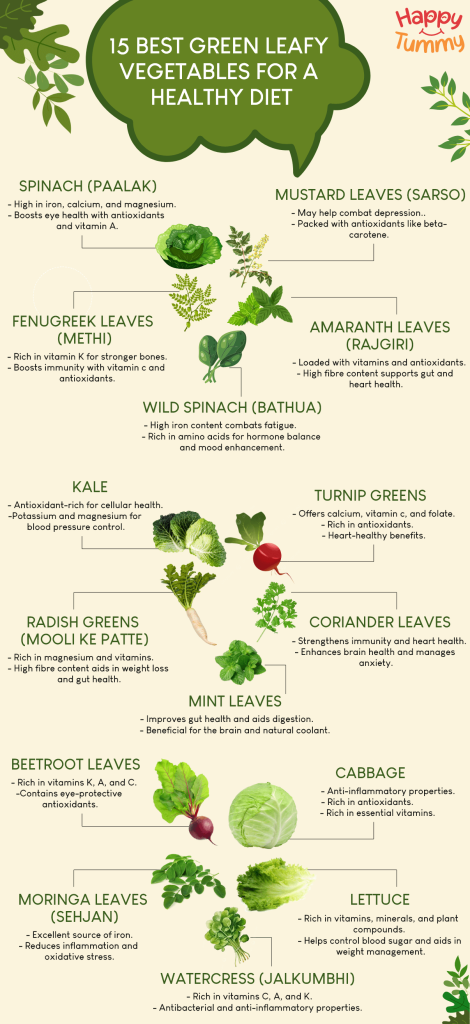Table of Contents
Imagine a world without the gorgeous green. The trees stand dead without leaves, the lands dry and dusty without any grass, and sea algae no more than a beautiful memory. Terrible right? Now, this gradually becomes of our bodies when we don’t feed them with enough greens. Because we’ve evolved with and around greens, we need them. And this is the reason doctors emphasize so much on consuming green vegetables.
Although all green vegetables are crucial, the leafy greens offer a bit more brilliance.
Worry about losing your memories as you age? Is your weight going beyond your control? Has your heart started troubling you? Don’t worry! Leafy green vegetables can offer brilliant amounts of benefits to our bodies. These greens are the true grace of god.
Today, we’ll tell you the 15 best green leafy vegetables that you must include in your diet to elevate your health, wealth, and happiness.

1. Spinach (Paalak)
Spinach is one of the best green leafy vegetables you can bless your body with. Not only do these green leaves offer wonderful amounts of iron, but they also offer numerous other benefits such as:
- Numerous minerals such as calcium, magnesium, etc.
- Improved eye health due to high antioxidant content and Vitamin A
- Better heart health due to reduced bad cholesterol
- Improved memory retention and protection as we age
And the list of benefits keeps growing.
Regular consumption of spinach can ease down your stiff heart vessels, as proved through various studies. [1]
However, as you make spinach as part of your healthy diet, ensure you consume it in healthy ways. The best is to add these to your salads, boil these leaves, blend them into smoothies, make curry, add to your rice, dal, etc. Just keep those palak pakoras away.
2. Fenugreek Leaves (Methi)
Trust us, these leaves might be a bit bitter, but not to your health. Methi leaves deserve a permanent spot on your plate! Here is why:
- These leaves offer crucial vitamin K content, which is essential for stronger bones
- Their vitamin C and other antioxidant content allows for a stronger immune system
- And because they have good fibre content, they offer strength to our digestive system
Fenugreek is one of the oldest medicinal plants that Ayurveda looked into [2]
Here is a leafy secret – Methi leaves can do wonderfully well against dandruff and other scalp infections induced by Malassezia.
Also, these leafy wonders are a diabetic’s delight. [3][4]
And don’t worry about the bitterness of methi leaves. Their bitterness turns into brilliance when you cook it in Indian style. Malai methi, saag, aalu methi, all these dishes can make you love it.
3. Mustard Leaves (Sarso)
We all must have heard of ‘sarso-da-saag’ once in our lives. It’s famous and for all the right reasons.
Mustard leaves pack a powerful punch of nutrients. It is one of the best green leafy vegetables you can add to your diet.
Mustard greens are a treasure trove of antioxidants, including beta-carotene, which protects your cells from damage linked to chronic diseases. [5]
And if you often find yourself dull and depressed, then pick up these leaves and start munching on them. Studies suggest mustard leaves contain strong anti-depressant properties that can help you knock down depression. Gradually! [6]
Mustard greens also contain compounds that help lower cholesterol and promote healthy blood flow. [7]
Don’t miss out on this flavorful and nutritious addition to your diet!
4. Wild Spinach (Bathua)
These leaves might be new to your dietary vocab if you don’t live in Northern India. These green leaves, also known by numerous other names such as
- Lamb’s quarter
- Melde
- White goosefoot, etc.
are something that you must start consuming.
The first reason bathua leaves are fantastic is their rich amino acid profile. Amino acids are extremely useful for our bodies because
- They help maintain healthy hormone levels
- They enhance mood
- Improvement in physical performance and recovery is experienced
- Wound healing gets quicker, etc.
And if you often feel sluggish, then Bathua’s iron content can help combat fatigue and promote healthy red blood cell production. [8][9]
5. Amaranth Leaves (Rajgiri)
As exotic do these leaves seem, equally beneficial they are. Also known as rajgiri, these leaves often come in two colours:
- Green rajgiri
- Red rajgiri
These leaves come from the Amaranth plant.
Firstly, amaranth leaves offer good fibre content, which is well known to promote gut health, weight loss, better heart health, etc. A 100-gram provides around 4-5 grams of fibre.
Apart from fibre, green rajgiri also provides a good amount of vitamins such as vitamins B1, B2, B3, B5, K, etc.
They’re also loaded with antioxidants that fight cell damage and may even help reduce inflammation in the body.
Amaranth greens have been found to offer exceptional amounts of iron and zinc. A mere 100 grams of these leaves may provide you with more than 50% of your daily requirement. [10][11]
6. Kale
Kale is everywhere these days. They are gracing smoothie bowls, adorning salads, and even supporting soups with their slightly bitter crown. And for all the good reasons.
We’re talking about an antioxidant army – beta-carotene, vitamin C – ready to neutralize free radicals and keep your cells young.
Want stronger bones? Kale’s got your back (and bones, of course) with a hefty dose of vitamin K.
Is blood pressure giving you grief? The potassium and magnesium duo in kale work wonders for keeping it in check.
From lowering cholesterol to enhancing eye health and supporting weight loss, kale is killing it.
7. Turnip Greens
Turnip, although a much-known name throughout India, does not get enough attention. But it should. Turnip greens are great when it comes to green leafy vegetables for many reasons:
- These leaves offer great amounts of calcium, vitamin C, folate, vitamin A, E, K, etc.
- Your heart can benefit much from these leaves.
- You get tons of antioxidants such as flavonoids, phenolic compounds, organic acids, etc.
Because turnip leaves have a strong taste like its root, you might want to blend these leaves with other leaves. But don’t leave these. [12][13]
8. Radish Greens
Often discarded, radish greens are great among the many greens out there. Similar to their turnip counterpart, radish greens (also known as mooli ke patte) offer excellent benefits. Here is why you must eat radish leaves:
- Their high fibre content improves gut health and helps in weight loss
- They stay rich in magnesium, vitamin C, K, etc.
- These leaves offer numerous heart-related benefits
- They also offer protection against numerous UTIs
Radish leaves have been used traditionally as a folk medicine since ancient times [14]
A few great recipes include radish leaves bhurji, leaf salad, etc.
9. Coriander Leaves
Smelling something refreshing? Well, such are coriander leaves and their relation with the Indian cuisine. Often relegated to a garnish or a finishing touch in curries, coriander (or cilantro, as some know it) must be consumed daily.
- These leaves can lower your blood sugar levels
- Your immunity can get the required strength
- Your heart may get several benefits due to its diuretic properties
- It can enhance brain health and manage anxiety as well
And the list goes on. [15][16][17][18][19]
The best way to consume? Garnish your curries or make delicious chutneys by mixing them with mint, green chilies, onion, ginger, garlic, etc.
10. Mint Leaves
Mint leaves are as refreshing as coriander leaves. And they taste so like heaven.
Mint leaves are medicinal. They offer numerous benefits such as:
- Improves gut health and helps with IBS
- Wonderful for indigestion
- Is beneficial for the brain
- Is a natural coolant
And can even help in breastfeeding pain when used as peppermint water or gel. [20][21][22][23]
11. Beetroot Leaves
We all know how healthy beetroots are for us. But their leaves? Equally beneficial.
Beet leaves are ignored much, but these should not be. Here is why:
- Beetroot leaves stay rich in essential vitamins such as K, A, C, etc.
- They offer a good amount of antioxidants such as zeaxanthin, lutein, etc.
These antioxidants are known to protect your eyes from cataracts and other issues like age-related macular degeneration.
How to eat? Toss them into salads, blend them into smoothies, or make some delicious saag out of these. [24][25]
12. Cabbage
Cabbage might seem like some sibling of cauliflower, but it actually is a leafy vegetable and a green one.
Cabbage is a big cluster of green leaves that offer numerous benefits apart from their delicious taste. Here is why you must it this wonderful veggie:
- These leaves offer anti-inflammatory properties that help in reducing pain, swelling, healing, etc.
- It stays high in antioxidants as well
- And it offers essential vitamins such as B1, B2, B3, etc.
However, this vegetable is prone to worms due to its leaves being enclosed and providing safe space for worms. Always make sure you buy one that is fresh and is grown in hygienic conditions. [26][27]
13. Moringa Leaves
Now, let’s turn to the rising star of the leafy green scene: moringa leaves. Forget the “supporting role” stereotype – moringa is a headliner in its own right.
Also called Sehjan in Hindi, these leaves are medicinal and offer numerous benefits.
Moringa leaves are an excellent source of iron, especially for individuals who follow vegetarian or vegan diets and may struggle to meet their iron requirements from plant-based sources. Consuming moringa leaves can help boost iron levels in the body and prevent iron-deficiency anemia.
These leaves are best known for reducing inflammation.
Moringa leaves are also rich in antioxidants, including flavonoids, polyphenols, and vitamin C. These antioxidants scavenge free radicals and reduce oxidative stress. Studies have shown that moringa leaf extract exhibits potent antioxidant activity, which can help protect against cellular damage and reduce the risk of chronic diseases
Apart from this, they are known to control blood sugar and control several other brutal issues. [28][29][30][31]
How to eat moringa leaves?
Blend in your salad, put in a sandwich or a wrap, make bhaji, chutney, etc., or consume in powdered form.
14. Lettuce
Lettuce is not one of your ordinary veggies. This green leafy vegetable is often found in burgers. But don’t consume it in these unhealthy ways.
Add lettuce to your green salad and you’ll be blessed with
- Numerous vitamins, minerals, and other plant compounds such as carotenoids, polyphenols, etc.
- May help control blood sugar and, thus obesity
Studies have found it to be quite effective at lowering blood sugar and insulin levels. [32][33][34]
15. Watercress
Sounds new? What about Jalkumbhi? Watercress, or alkumbhi, is a green leafy vegetable that grows on water. For centuries, humans have used it medicinally due to its numerous benefits.
- Watercress contains rich amounts of vitamins such as C, A, K, etc.
But this is not all.
Numerous studies have found watercress to be antibacterial, anti-inflammatory, heart-healing, liver-health enhancing, kidney-protecting, and full of antioxidants. [35]
Because these leaves are slightly better, it is best to combine them with other green leafy vegetables.
The Green Bottom Line
So there you have it! These are just 15 of the countless leafy green warriors waiting to be incorporated into your army of health. From the well-known spinach to the rising star moringa, each green powerhouse offers a unique blend of vitamins, minerals, and antioxidants.
Spinach, fenugreek, mustard, amaranth, kale, radish, coriander, mint, lettuce, and the trendy moringa, all these green leafy vegetables must be embraced to have a healthier and happier life.
Remember, a world without greens is a world without vibrancy, and so is your body. So, stock your fridge, embrace the earthy flavours, and watch your health flourish with every delicious bite!
FAQs
The healthiest green leafy vegetable is subjective and depends on various factors such as nutritional content, personal taste preferences, and dietary requirements.
However, some of the most nutritionally dense green leafy vegetables include kale, spinach, Moringa, Swiss chard, collard greens, and arugula. These vegetables are rich in vitamins, minerals, fibre, and antioxidants, making them excellent choices for promoting overall health and well-being.
Incorporating a variety of green leafy vegetables into your daily diet benefits overall health. Aim to include a mix of seasonal greens such as spinach, Swiss chard, mustard greens, collard greens, arugula, and romaine lettuce.
Each type of green leafy vegetable offers a unique combination of nutrients, so consuming a diverse range ensures you obtain a wide array of vitamins, minerals, and phytonutrients essential for optimal health.
Yes, including green leafy vegetables in your daily diet is generally safe and recommended. Green leaves are low in calories and rich in essential nutrients, including vitamins (such as vitamins A, C, and K), minerals (such as calcium, magnesium, and potassium), and antioxidants.
Consuming green leaves daily can help support overall health, boost immunity, promote digestion, and reduce the risk of chronic diseases.















